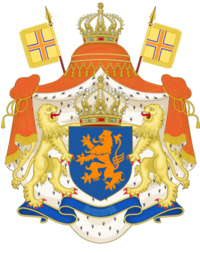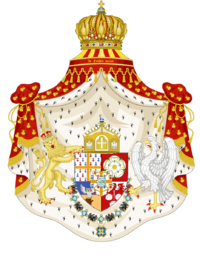Pact of Benacium: Difference between revisions
(Created page with "{{Arcadia Article}} {{Batavia Article}} {{Francia Article}} {{FBE Article}} The '''Pact of Benacium''' is the founding document adopted by the Kingdom of Batavia a...") |
(No difference)
|
Revision as of 21:06, 23 May 2020
The Pact of Benacium is the founding document adopted by the Kingdom of Batavia and the Frankish Empire, through which the supranational union was founded: Franco-Batavian Empire.
Text in Common Tongue
PACT OF BENACIUM In times of great concern, the representatives of the Kingdom of Batavia and the Frankish Empire have come together to deal with the matters for which they stand. Together with their autonomous regions: United Kingdom of Arcadia, the Beneluccas and the land of the Calbain, Grand Duchy of Helderbourgh, Autonomous Province of Mishalacia and Kingdom of Ravaria.
To this end they have decided jointly:
Article I – The Union
The Kingdom of Batavia and the Frankish Empire form an inseparable union under this pact. This union gets the name: Franco-Batavian Empire.Article II - Head
His Imperial and Royal Majesty, Arkadius Frederik Gustavus des Vinandy, Emperor of Francia, King of Arcadia, King of Amokolia, King of Batavia, Grand Duke of Helderbourgh is the head of the union and his successors.Article III - Temporariness
The union will exist for a term of 10 Norton years. At the end of this period the parliaments of Batavia and Francia will decide on the future of the union. As long as no decision has been made the union will be prolonged.Article IV - Administrative Centre
The city, from whose name this pact is taken, will be set up as the administrative centre of the union. The necessary institutions will be established in that city.Article V - Symbols
The flag consists of three equal horizontal stripes in the colours dark blue (the colour of Arcadia), red (the colour of Francia) and orange (the colour of Batavia). The coat of arms consists of two halves: the left half is the eagle of Brandenburg and the right half is the lion of Batavia.Article VI - Map
The map, provided by the Micronational Cartography Society, shows all parts of the union in one political colour.Article VII - Powers
The powers of the Union include military, foreign and territorial policy.Article VIII - Executive
The executive consists of the head and the supervisory directors appointed by him. These commissioners may be dismissed by a majority of the House of Representatives of the Union Parliament or by the head.Article IX - Legislative
The Union Parliament, composed of two chambers, is established as the legislative power: First Chamber is composed of delegates from Batavia, Francia and their autonomous regions. The Second Chamber is elected by direct suffrage among all citizens of full age within the Union for a term of five Norton years.Article X - Judiciary
The Court of the Union shall be established as a judiciary.Article XI - Transition
As far as necessary, countries will incorporate the provisions of this Pact as soon as possible. Powers shall be transferred and further formalised defacto as from this Pact.Article XII - Approval
This pact enters into force after approval by the respective parliaments of Batavia and Francia.Article XIII - Amendments and Annexes
This pact can only be modified by the parliaments of Batavia and Francia. Annexes may be added to this pact by the Union Parliament in order to elaborate articles in this pact.
Text in Batavian
PACT VAN BENACIUM In tijden van grote bezorgdheid zijn de vertegenwoordigers van het Koninkrijk Batavia en het Frankische Rijk samengekomen om de zaken te behandelen waarvoor ze staan. Samen met hun autonome regio's: Verenigd Koninkrijk Arcadië, de Benelukken en het land van de Calbain, Groothertogdom Helderbourgh, Autonome provincie Mishalacia en Koninkrijk Ravaria.
Daartoe hebben zij gezamenlijk besloten:
Artikel I – De Unie
Het Koninkrijk Batavia en het Frankische Rijk vormen in het kader van dit pact een onafscheidelijke unie. Deze unie krijgt de naam: Frankisch-Bataafs Rijk.Artikel II – Het Hoofd
Zijne Keizerlijke en Koninklijke Majesteit, Arkadius Frederik Gustavus des Vinandy, Keizer van Francia, Koning van Arcadië, Koning van Amokolië, Koning van Batavia, Groothertog van Helderbourgh is het hoofd van de unie en zijn opvolgers.Artikel III – Tijdelijkheid
De unie zal bestaan voor een termijn van 10 Nortonjaren. Aan het einde van dit termijn wordt door de parlementen van Batavië en Francia besloten over de toekomst van de unie. Zolang er geen besluit is genomen wordt de unie verlengt.Artikel IV – Bestuurscentrum
De stad, van wiens naam dit pact wordt ontleend, wordt ingericht als bestuurscentrum van de unie. In die stad zullen de nodige instituten worden gevestigd.Artikel V – Symbolen
Als vlag wordt gevoerd, bestaande uit drie gelijke horizontale banen in de kleuren: donkerblauw (de kleur van Arcadië), rood (de kleur van Francia) en oranje (de kleur van Batavië). Als wapenschild wordt gevoerd, bestaande uit twee helften: linkerhelft de adelaar van Brandenburg en de rechterhelft de leeuw van Batavië.Artikel VI – Landkaart
Op de landkaart, verzorgd door de Micronational Cartography Society, wordt alle landsdelen van de unie weergegeven in één politieke kleur.Artikel VII – Bevoegdheden
De bevoegdheden van de unie omvatten het militair-, buitenland- en territoriaal beleid.Artikel VIII – Uitvoerende macht
De uitvoerende macht bestaat uit het hoofd en de door hem benoemde commissarissen. Deze commissarissen kunnen door een meerderheid van de Tweede Kamer van het Unieparlement of door het hoofd worden ontslagen.Artikel IX – Wetgevende macht
Als wetgevende macht wordt het Unieparlement opgericht, bestaande uit twee kamers: Eerste kamer wordt samengesteld uit afgevaardigden uit Batavië, Francia en hun autonome regio’s. Tweede kamer wordt middels rechtstreekse verkiezingen onder alle meerderjarige burgers binnen de unie voor een termijn van vijf Nortonjaren.Artikel X – Rechterlijke macht
Als rechterlijke macht wordt het Hof van de Unie ingesteld.Artikel XI – Transitie
De inpassing van de bepalingen in dit pact wordt, zover nodig, zo snel mogelijk door de landen verwerkt. De bevoegdheden worden defacto met ingang van dit pact overgedragen en nader geformaliseerd.Artikel XII – Goedkeuring
Dit pact treedt in werking na goedkeuring door de respectievelijke parlementen van Batavië en Francia.Artikel XIII – Wijziging en annexen
Dit pact kan alleen gewijzigd worden door de parlementen van Batavië en Francia. Aan dit pact kunnen door het Unieparlement annexen worden toegevoegd ter uitwerking van artikelen in dit pact.
Text in Germanian
PAKT VON BENACIUM In Zeiten großer Besorgnis sind die Vertreter des Königreichs Batavia und des Fränkischen Reichs zusammengekommen, um sich mit den Angelegenheiten zu befassen, für die sie stehen. Zusammen mit ihren autonomen Regionen: Das Vereinigte Königreich Arkadien, die Benelukken und das Land der Calbain, das Großherzogtum Helderbourgh, die Autonome Provinz Mishalacia und das Königreich Ravaria.
Zu diesem Zweck haben sie gemeinsam entschieden:Artikel I - Die Union
Das Königreich Batavia und das Fränkische Reich bilden im Rahmen dieses Paktes eine untrennbare Union. Diese Union erhält den Namen: Fränkisch-Batavisches Reich.Artikel II - Haupt
Seine Kaiserliche und Königliche Majestät, Arkadius Frederik Gustavus des Vinandy, Kaiser von Francia, König von Arkadien, König von Amokolien, König von Batavien, Großherzog von Helderbourgh ist das Oberhaupt der Union und seine Nachfolger.Artikel III - Vorläufigkeit
Die Union wird für eine Amtszeit von 10 Norton-Jahren bestehen. Am Ende dieses Zeitraums werden die Parlamente von Batavia und Francia über die Zukunft der Union entscheiden. Solange keine Entscheidung getroffen wurde, wird die Union verlängert.Artikel IV - Verwaltungszentrum
Die Stadt, von deren Namen dieser Pakt übernommen wurde, wird als Verwaltungszentrum der Gewerkschaft eingerichtet. In dieser Stadt werden die erforderlichen Institutionen eingerichtet.Artikel V - Symbole
Die Flagge besteht aus drei gleichen horizontalen Streifen in den Farben Dunkelblau (die Farbe Arkadiens), Rot (die Farbe Frankenreichs) und Orange (die Farbe der Batavia). Das Wappen besteht aus zwei Hälften: die linke Hälfte ist der Adler von Brandenburg und die rechte Hälfte der Löwe von Batavia.Artikel VI - Karte
Die Karte, die von der Micronational Cartography Society zur Verfügung gestellt wurde, zeigt alle Teile der Union in einer politischen Farbe.Artikel VII - Befugnisse
Zu den Befugnissen der Union gehören die Militär-, Außen- und Territorialpolitik.Artikel VIII - Exekutive
Die Exekutive besteht aus dem Leiter und den von ihm ernannten Aufsichtsdirektoren. Diese Beauftragten können von der Mehrheit des Repräsentantenhauses des Unionsparlaments oder vom Leiter abberufen werden.Artikel IX - Legislative
Das Unionsparlament, das aus zwei Kammern besteht, wird als gesetzgebende Gewalt eingerichtet: Die erste Kammer setzt sich aus Delegierten aus Batavia, Francia und ihren autonomen Regionen zusammen. Die Zweite Kammer wird in direkter Wahl von allen volljährigen Bürgern der Union für eine Amtszeit von fünf Norton-Jahren gewählt.Artikel X - Justizwesen
Der Unionsgerichtshof wird als Gericht eingerichtet.Artikel XI - Übergang
Soweit erforderlich, werden die Länder die Bestimmungen dieses Paktes so bald wie möglich übernehmen. Die Befugnisse werden ab diesem Pakt defacto übertragen und weiter formalisiert.Artikel XII - Billigung
Dieser Pakt tritt nach Billigung durch die jeweiligen Parlamente von Batavia und Francia in Kraft.Artikel XIII - Änderungen und Anhänge
Dieser Pakt kann nur von den Parlamenten von Batavia und Francia geändert werden. Das Parlament der Union kann diesem Pakt Anhänge beifügen, um Artikel dieses Paktes auszuarbeiten.

